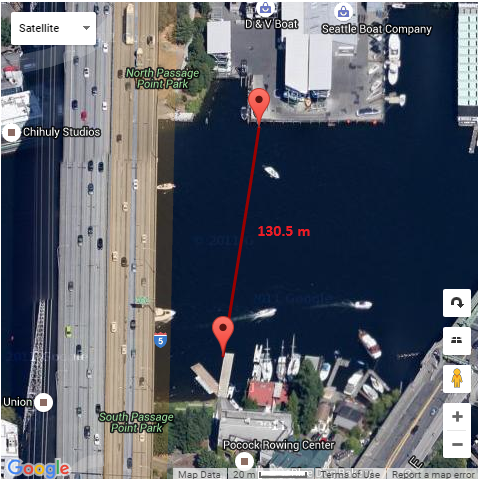
September 29th summary : Node to Node Characterization
For full report please click here.
Experiment location:
Node2 at Seattle Boat Company (SBC), Node3 at Pocock (Fig1.)

Figure 1: Experiment Location
Figure 2 depicts the packet delivery ratio
(PDR) for each mode. Expected behavior is to see improvement in PDR as
transmission power(TXPWR) increases. The expectation was met from MODE1 to the
second trial of MODE4, however, we see performance drop at 3rd trial
(-10dB) of MODE4 and failed to transmit at MODE5 all together.

Figure 2: Packet Delivery Ratio
Figure 3 presents the ESNR performance in this experiment (definitions can be
found in Ref.1) Generally speaking, ESNRs increase with transmission power
increment, until at certain points they reach constant levels. ESNR achieves
constant level much earlier due to the limitation brought by channel estimation
error. Overall, ESNR values in this test condition are low (average 9 dB), which
indicates channel couldn’t handle high data rate (Ref. 2.) Ideal channel should
consistently produce ESNR above 10 dB to enable high data rates (Mode4 and 5.)
Moreover, ESNR seems to be mode
independent.

Figure 3: ESNR as a function of TXPWR,
seems mode independent.
CIR results
consistently show a delay spread of around 28ms (Figure 4.)

Figure 4: Example CIR reading
Figure 5 shows
CIR in frequency domain between to different CIRs, one taken in the morning with
a “good behaving channel” and the other in the afternoon with “harsh channel
conditions.” It seems noise levels in magnitude response in the afternoon CIR is
larger than the morning one. This can be a good reason for lower ESNR despite
transmitting signals with considerably higher TXPWR. Moreover, phase change
seems to be faster in the afternoon, which is the main influence factor of the
performance.

Figure:
Comparison between CIR taken in morning and afternoon